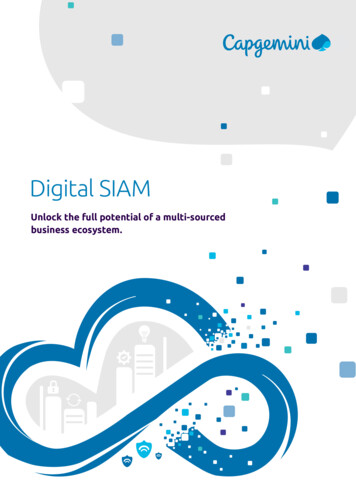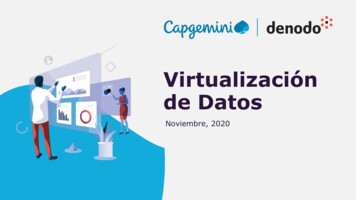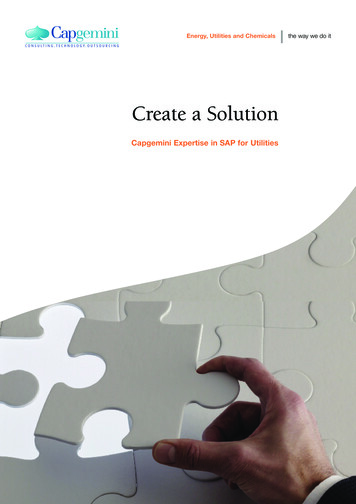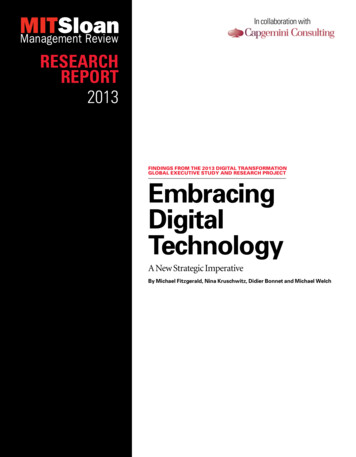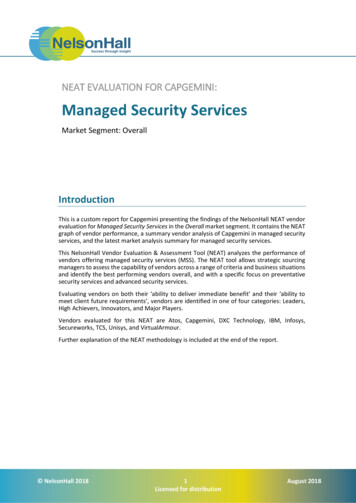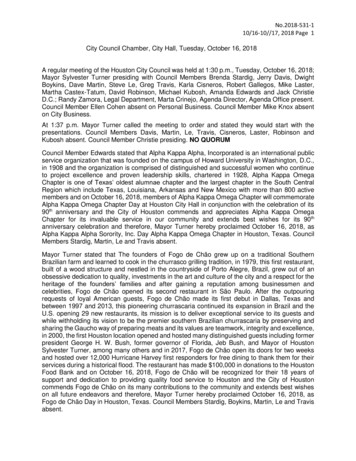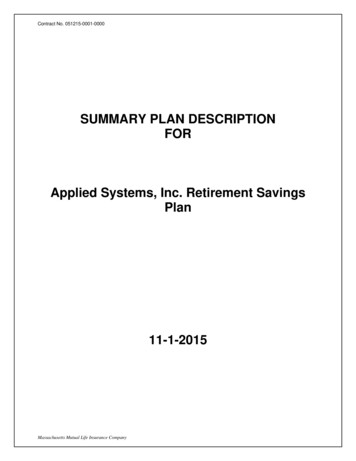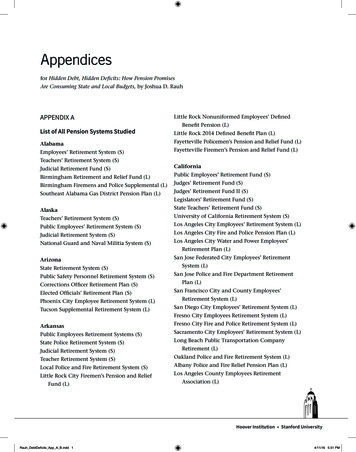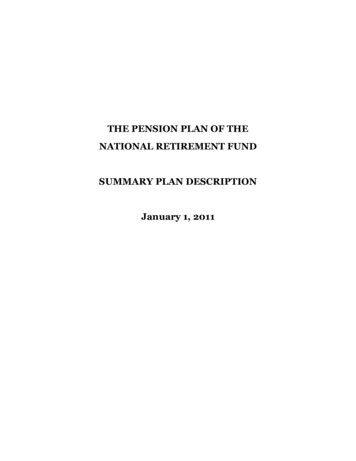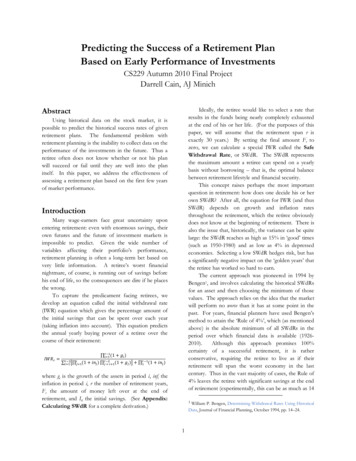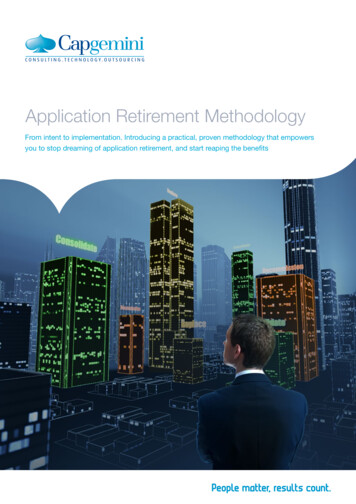
Transcription
Application Retirement MethodologyFrom intent to implementation. Introducing a practical, proven methodology that empowersyou to stop dreaming of application retirement, and start reaping the benefits
WARP the way we see itThe application landscape today.The challenge for the CIO.Years of unbridled growth have left the typical application landscape bloated and in needof streamlining. The need to act and retake control of the application landscape is clear.Application Rationalization is often identified as the solution. Rationalization can takemany forms, including the retirement of applications. Indeed, retirement is oftenidentified as one of the most beneficial rationalization actions and among the mostdesired by CIOs. And yet, experience tells us that while the need or desire to retire moreapplications is clear, many organizations find that the obstacles associated with thistask are sufficiently prohibitive as to cause many such initiatives to be abandoned beforepositive action can be initiated.Retiring an application that has been part of an enterprise’s technology landscape foryears, perhaps even decades, is not a simple case of clicking ‘uninstall’. Users, businessprocesses, interdependencies between different applications, and many other factorsneed to be considered before decisions and action can be taken.What’s more, while hundreds or even thousands of new applications are createdeveryday, how many are retired? The massive discrepancy between the number ofapplications that have been developed and the number that have been retired indicatesthat experience and available knowledge on the topic of application retirement is limited.All of this begs the question:Even if you have identified which applicationsshould be retired, how do you go from intentto implementation?This white paper represents a first step in how to answer this, and puts forwardCapgemini’s Application Retirement Methodology as a proven solution to this problem.The methodology comprises a coherent set of principles that can be used to retire thoseapplications considered to be obsolete.When delivered as a continuation of a rationalization analysis exercise, such asCapgemini’s Wide-angle Application Rationalization Program (WARP), the ApplicationRetirement Methodology provides the means by which to progress from identifyingopportunities for application retirement to actually reaping tangible benefits from thisexercise. The methodology as a whole consists of industrialized process flows, artifacts,frameworks, tools and techniques that, together, address many of the problemsencountered by CIOs when seeking out the best path towards retiring applications.By providing a structured approach to implementing application retirement, Capgemini’sApplication Retirement Methodology serves as a key enabler in simplifying andstreamlining the application landscape. A simplified, streamlined application landscapeimproves IT’s ability to support the business and its ever-evolving needs. Using themethodology put forward in this paper, all of this can be achieved in a safe and controlledmanner.Application Retirement Methodology2
WARP the way we see itWhat are the main benefits of anApplication Retirement Methodologyand how does Capgemini’s approachachieve these benefits?Broadly speaking, the key benefits that Application Retirement can deliver are Significant cost savings; More efficient utilization of critical resources; Freeing up of headroom and budget so that resources and funding can be directedtoward adding value to the business.The benefits are clear, as is the intention. But implementation? To better enableenterprises to go from intent to implementation, Capgemini’s methodology is builtaround:The key benefitsof ApplicationRetirement aresignificant costsavings, efficientutilization ofresources, and thecreation of headroomto innovate.1. A unique suite of processes, tools and techniques to facilitate the implementationof application retirement projects;2. Managing compliance risk using best-practice archiving and retrievalmethods;3. Planning operational cost reduction in a way that considers both functionaland personnel requirements;4. Eliminating maintenance costs by optimizing the usage of licenses within thedesign;5. Efficient re-use of capital;6. Reducing the strain and dependency on finite data center resources.Capgemini’s Application Retirement Execution Methodology offering provides theclient with a detailed framework and set of artifacts for effectively executing applicationretirement, and resultantly, simplifying their application landscape. This methodologybuilds on Capgemini’s Wide-angle Rationalization Program (WARP). WARP is used toidentify rationalization opportunities within the client application landscape and identifythose applications that are suitable for consolidation, replacement or decommissioning.WARP does not comprise implementation, but serves as a ‘decision catalyst’ withinthe overall rationalization exercise. The route to implementation is mapped out inCapgemini’s Application Retirement Methodology. This methodology is based aroundthree key application scenarios: Application ConsolidationRemoving obsolete applications and augmenting more-relevant applications tocover any functionality gap caused by removing the obsolete application. Application ReplacementReplacing existing applications with new ones. Application DecommissioningComplete removal of applications found to be obsolete and servingno useful purpose.Application Retirement Methodology3
WARP the way we see itStrategies applied within Capgemini’s Application Retirement MethodologyWARP AssessmentConsolidateReplaceDecommissionHard SavingsThe retirement framework used in the methodology consists of four phases:1. Decide – This comprises a series of analyses whereby redundancy, retirementand risk analysis are performed. Redundancy and retirement analysis are performed toidentify and validate the candidates for this decommissioning. This phase can take placeeither based on the findings of a WARP exercise, or, if a client has already defined whichapplication or applications need retiring, this action can take place immediately.2. Plan – This stage comprises the development of a set of workflows and analyses,the principal ones being impact analysis, estimation analysis, and cost/benefit analysis.At this stage, the level of risk implied by the project is identified, and a plan for personnelreorganization is devised. Whether or not to proceed depends on whether the emerging‘plan’ contains sufficient financial benefit and with minimal threat of disruption.The RetirementMethodologyphases are decide,plan, design andimplement.”3. Design – A workflow. The result is a system architecture ‘design’. This facilitates thetraceability of functionality and also provides test cases for ensuring a seamless workflow.The decision on whether to proceed to the next phase depends on the architecturedesign being approved by the client.4. Implement – This consists of an ‘implementation’ workflow: a series of checklists,test scripts execution, and re-skilling training for resources. Once this workflow issigned off, the client is able to successfully approve the retirement of the application orapplications.To explain the mechanics behind this model further, The Application RetirementFramework diagram provides an overview of the processes and actions that makeup this exercise.The Application Retirement FrameworkScenarioDECOMMISSIONComplete removal of obsolete application(s)REPLACEReplacement of application(s) with new application(s)CONSOLIDATEReplacement of application(s) with augmented old ment of client-identified applicationsRetirement of applications using exhaustive WARP methodologyApplication Retirement Methodology4
WARP the way we see itThe Different Retirement Strategy ScenariosIn order to better understand how the Capgemini Application Retirement Methodologyis implemented in practice, the following table consists of three possible retirementscenarios, the objective of each one, and the tools and techniques that can be usedto achieve this.A depiction of the various retirement strategy es Business case for choiceof ‘Decommission’ Feasibility/Impact Analysis Requirements Traceability Artifact Customer Sign off on RetirementRemoving obsolete applicationswhose removal does not impactthe overall functionality of theenterprise Identifying and replacing oldapplications with new applicationswhose introduction ensuresreplication of existing functionalityin the enterprise Functional Redundancy Analysis Tool Risk Analysis Tool Framework for selection betweenCOTS/Build/Migrate New Application Selection Framework Effort Estimation Tool Design Checklist Testing & Data Migration Tools ‘Retirement Ready’ Checklist Business case forchoice of ‘Replace’ Feasibility/Impact Analysis Requirements Traceability Artifact Application Architecture Design Executed Test Scripts Customer Sign off on RetirementAims to improve the applicationlandscape by identifying andreplacing old applications byaugmenting the functionalities ofother existing applications in thelandscape Functional Redundancy Analysis Model Target Application SelectionFramework Effort Estimation Tool Design Checklist Testing & Data Integration Tools ‘Retirement Ready’ Checklist Business case for choiceof ‘Consolidate’ Feasibility/Impact Analysis Requirements Traceability Artifact Application Architecture Design Executed Test Scripts Customer Sign off on RetirementConsolidateReplaceTools & TechniquesRetirement Analysis ModelEffort Estimation Tool‘Retirement Ready’ ChecklistData Archival and Backup ToolsThe RetirementMethodologyaddresses the keystrategy scenariosof decommission,replace andconsolidate.”Key artifacts leveraged within the Retirement MethodologyThe Application Retirement Methodology contains an extensive library of artifactsthat are used to achieve the objectives listed in the various retirement scenarios.A list of some of the most important artifacts can be found below: Organization Landscape Questionnaire; Data Gathering Worksheet; WARP Recommendations Summary Sheet; Impact Analysis Report; Requirements Scope Summary; Estimation Analysis; Cost/Benefit Analysis; Selection of tools for performing data archiving/migration and integration; Requirements Traceability; Data Scan Report; Data Quality Improvement Strategy; Data Archiving/Migration/Integration Strategy; Test Plan; Extraction Procedures; Archiving Procedures; Data Archiving/Migration/Integration Reports; Dismantle Plan/Report; Incident Report; Risk mitigation plan.Application Retirement Methodology5
WARP the way we see itTechnology-specific solutions for retirement strategiesEach of the standard retirement strategies – consolidate, replace and decommission– have been customized with a set of tools, artifacts and frameworks based on thefollowing technologies:01 SAP02 Oracle03 Legacy Systems04 Microsoft05 JavaThe Retirement Methodology grid for technology-specific solutionsStandard Retirement sRetiring an application without a target applicationRetiring an old application and replacing its functionality with a new applicationRetiring an old application by consolidating its functionality with existing application/sSAPORACLELEGACYMICROSOFTJAVAOTHERSBy providing a bridge between an understanding of the benefits of Application Retirementand how to achieve Application Retirement effectively and safely, Capgemini’s ApplicationRetirement Methodology represents a significant step towards a rationalized, streamlined,simplified application landscape.Whereas a dearth of experience in this domain or lack of a structured approach hadpreviously hampered CIO attempts to reduce the bulk and complexity of their applicationlandscapes, Capgemini’s approach provides a proven and safe means of retiring thoseapplications that can be considered obsolete. By adopting this methodology – either asa continuation of a WARP engagement or after proprietary analysis – client organizationscan progress from the hypothetical stage of application rationalization to a point wherethey can start experiencing tangible benefits.When a client elects to use Capgemini’s Application Retirement Methodology asa continuation of a WARP engagement, they can benefit from an end-to-end solution thattakes them from identifying where rationalization opportunities exist within the applicationlandscape (including a detailed understanding of the benefits – both business andtechnology) right through to acting on these findings and experiencing tangible benefits.Application Retirement Methodology6
WARP the way we see itWhat is WARP?WARP is Capgemini’s proprietary approach to modernizing your IT landscape andindustrializing your IT processes. It is a hypothesis-driven approach that combines hardfact-finding with deep business insight and sensitivity.The WARP Framework – Four streams underpinned by two engines.WARP consists of four ‘streams’ underpinned by two ‘engines’. These streams are path(vision, architecture and solution), bizz (business analysis), case (the business case – fromboth a financial and value perspective) and plan (change planning, change scenarios andthe roadmap). Experience shows that the success of any rationalization program is greatlyimproved by the presence of these four streams.WARP - Wide-angle Application Rationalization ProgramEngine AMBILandscape Governance and IndustrializationStream PATHVision, Architecture and Rationalization DesignStream BIZZBusiness Process AnalysisStream CASEBusiness Case and ValueStream PLANChange Readiness and Transformation RoadmapEngine APPSApplication Portfolio AssessmentPLOTSCANCRAFTSOLVEThe two engines – apps and ambi – are highly industrialized ‘lenses’ that are used toanalyze both the technology, or apps landscape (the application portfolio), and also ambientfactors. While the apps engine provides an industrialized analysis of the portfolio, ambilooks beyond the technology and analyzes the context in which the application finds itself,including the relationship between the business, the processes and data harmonization.This framework of streams and engines ensures that each WARP engagement followsa comprehensive and structured approach. The streams focus on the core activities ofa rationalization program, while the engines use industrialized patterns to generate powerfulinsights. The findings are used to identify opportunities to dramatically modernize yourapplication estate, industrialize your IT processes and improve your organization.Find out more atwww.capgemini.com/warpApplication Retirement Methodology7
WARP the way we see it Application Retirement Analysis FrameworkWhite PaperCapgemini’s Application Retirement Analysis Framework serves as a tool foridentifying which applications within the application portfolio can be consideredfor retirement. The framework itself is based on measuring the overall impact thatretiring an application can have on the portfolio and organization as a whole. Assessment of Application Risk & Mitigation RecommendationsWhite PaperCapgemini’s proprietary Risk Assessment Model is a tool that will help ITdecision makers to gauge the level of risk in their application landscape andbetter understand where that risk lies, what form it takes, and what its impacton strategic business objectives is. Based on insight generated by multi-angleanalysis, a selection of strategies and recommendations is suggested aimed atmitigating risks discovered. Application Portfolio Cost Reduction StrategiesWhite PaperThis paper proposes the use of Capgemini’s Cost Reduction StrategiesMethodology as part of a broader portfolio analysis in which cost reduction is akey objective. This methodology is based on a set of ‘lenses’, with each usedto analyze the application landscape from a different perspective. The commonobjective is to reduce the overall costs associated with ownership and operationof the application portfolio. Holistic Assessment Model to Determine Application ValueWhite PaperThe Capgemini Holistic Assessment Model is proposed as a means ofdetermining the true value delivered by an IT application to the organization. Itenables decision makers to focus on increasing the overall technical, functionaland business value of the application landscape, and improving its overall costeffectiveness. WARP: Wide-angle Application Rationalization ProgramBrochureCapgemini’s WARP Methodology is also supported by a comprehensive fourpage brochure. This brochure showcases, holistically, the value that Capgemini’sWARP can add to the business, and highlights the underlying mechanismsthat are at the core of the framework. It also acts as a facilitator, of sorts, tyingtogether the WARP story told by the five white papers.Find out more about WARP and download the white papers atwww.capgemini.com/warpApplication Retirement Methodology8
www.capgemini.com/warpFor further information on WARP, please contact:Alex WortmannSaurabh LaddhaWARP Executive Sponsoralex.wortmann@capgemini.comLead, WARP Center of Excellencesaurabh.laddha@capgemini.comAbout CapgeminiWith more than 125,000 people in 44 countries, Capgemini is one of theworld’s foremost providers of consulting, technology and outsourcingservices. The Group reported 2012 global revenues of EUR 10.3 billion.Together with its clients, Capgemini creates and delivers business andtechnology solutions that fit their needs and drive the results they want.A deeply multicultural organization, Capgemini has developed its ownway of working, the Collaborative Business ExperienceTM, and draws onRightshore , its worldwide delivery model.Learn more about us atwww.capgemini.comThe information contained in this document is proprietary. 2013 Capgemini. All rights reserved.Rightshore is a trademark belonging to Capgemini.
6. Reducing the strain and dependency on finite data center resources. Capgemini's Application Retirement Execution Methodology offering provides the client with a detailed framework and set of artifacts for effectively executing application retirement, and resultantly, simplifying their application landscape. This methodology
